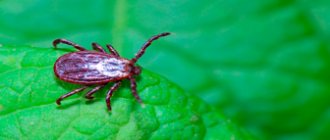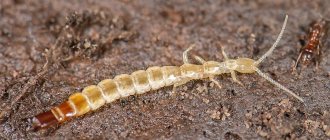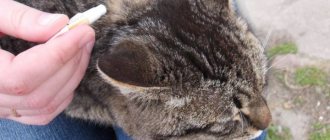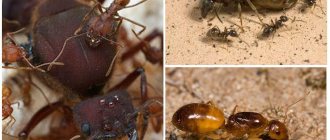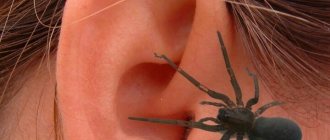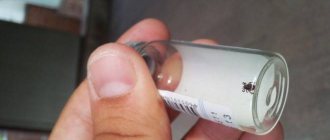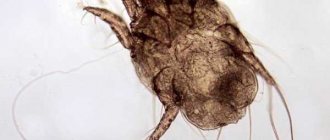First aid for a tick bite victim - what to do at home?
The danger of ticks is that these blood-sucking insects are carriers of many infections, both bacterial and viral, among which the most dangerous are hemorrhagic fevers, encephalitis and borreliosis. The traditional habitat of ticks is wooded areas; the greatest activity is observed in the warm season, from approximately mid-spring to mid-summer. During this period, you need to be especially careful when visiting the forest - it is best to wear closed clothing.
If trouble does occur, you should know how to properly provide first aid at home for a tick bite in order to minimize the possible danger. It must be remembered that severe infectious diseases transmitted by ticks appear some time after the bite, and this time can vary widely - from several days to several weeks. Only when no unpleasant symptoms appear within two months after a tick bite can we say that the danger has passed.
A tick bite is insidious in that it is often not detected immediately, since in itself it does not cause any sensations; all the troubles begin later. As a rule, a person discovers a tick attached to himself - the bite can last from 15 minutes to several hours.
First aid for a tick bite
The first thing you need to do to provide first aid to the victim at home is to remove the tick. This should be done very carefully, trying not to crush the insect, since in this case the risk of infection increases many times over.
To remove the tick, you can use medical tweezers, a special device sold in pharmacies, or a loop made from thread yourself. You should try to grab the insect closer to the head, remove it slowly, pull it perpendicular to the skin, while making rocking or slightly rotating (screwing) movements.
The removed tick must be placed in a small glass container with water, equipped with a tight-fitting lid.
After first aid has been provided and the insect has been completely removed, the wound is washed with soap and water, then treated with an antiseptic. If the tick's proboscis breaks off and remains in the skin, it should not be picked out; after a while - usually this takes several days - it will come out on its own. The bite site is treated in the same way.
Contrary to the often described so-called folk methods, you cannot drip oil, alcohol or any other liquid onto a tick, or burn it so that its breathing becomes impaired and it falls off on its own. In this case, the risk of infection is extremely high, since when breathing is impaired, the insect secretes saliva into the wound, which most likely contains a huge amount of pathogenic microorganisms.
Precautionary measures
Ticks usually begin to become active in May and lead an active lifestyle until September. The peak of their life activity occurs in the summer. Before heading to an area where there are ticks, it is advisable to get an anti-encephalitis vaccine about 30-40 days in advance. You should also take with you special tools, which are divided into three main groups:
- Repellents. They are good at repelling ticks and other insects.
- Acaricides. They kill almost all types of blood suckers.
- Insecticidal and repellent agents. These are substances that can both kill and repel insects.
While in the forest or areas with plantings, you should not go into wet and shaded areas where there is dense vegetation. Unless absolutely necessary, you should not climb into raspberry and aspen forests. Parasites are very common in such places. Quite a lot of ticks can be found on the sides of forest paths.
To enhance safety, it is best to stick to bright places that do not have a large number of bushes - for example, pine forests, open clearings that can be seen. It should be remembered that the daily peak of activity occurs in the morning and evening. In rainy or hot weather, insects are inactive.
You should also choose the right clothes before going on a hike. It is better if it is light in color, as this allows you to quickly identify the parasite. It is advisable to choose outerwear from Bolognese fabrics. A shirt or T-shirt must be tucked into pants.
What to do with a removed tick?
If you are in a region where there are known cases of tick-borne encephalitis or other infectious diseases transmitted by ticks, then immediately after providing first aid, you must take the extracted insect to the laboratory for analysis. Addresses of laboratories in Russia can be found in Rospotrebnadzor.
Typically, the results of the study are ready on the same day or the next, and depending on them, a decision is made on further actions. If it is not possible to take the tick for analysis, then you should monitor the health of the victim. If the signs of inflammation at the bite site disappear within 1-2 days, the likelihood of developing any pathology is considered minimal. However, if after 2 days redness and swelling remain at the site of the bite, and even more so if they increase, you should consult a doctor immediately. Body temperature should be measured and recorded for 10 days after the bite.
An increase in temperature during this period may indicate the onset of an infectious disease, in which case it is also necessary to seek medical help.
Tests to detect infection
There are several types of diagnostics that help detect a dangerous infection in the human body.
Most often, doctors recommend taking an enzyme-linked immunosorbent assay (ELISA). At the initial stage of infection, it is not effective because it cannot detect the virus, but at the middle stage of development it shows good results. It is used to detect encephalitis and borreliosis.
In order to immediately detect infection, a polymerase assay (PCR) is used. This is the fastest possible analysis that can be carried out immediately after the bite. Western blotting is also used, in this case a detection method is used, as in the ELISA analysis, but differs in that the infection can be diagnosed at an early stage.
Not all clinics conduct these studies; it all depends on the capabilities of the laboratory. Therefore, the doctor gives directions for the necessary tests that can be carried out in these conditions.
Symptoms and treatment of diseases caused by tick bites
So, let's look at the symptoms and treatment of the main diseases caused by a tick bite.
Tick-borne borreliosis
Borreliosis (Lyme disease) is the most common tick-borne infectious disease in the Northern Hemisphere. In Russia, it is found in the forest-steppe zone from Sakhalin to Kaliningrad. The most common and noticeable symptom of borreliosis is redness at the site of the tick bite (erythema), which usually appears no earlier than a week after the bite. The redness increases in size and can reach several tens of centimeters in diameter. In this case, the center may become lighter, and the redness may take the form of a ring. If redness occurs at the time of the bite, then this is most likely not a manifestation of borreliosis, but a reaction to a tick bite.
First signs:
- headache;
- pain in joints, muscles;
- chills;
- increase in body temperature;
- vomit;
- soreness, itching and redness at the site of the bite.
The danger of tick-borne borreliosis is that signs of infection may appear only several months after the bite. During this time, irreversible processes will occur in the body.
The disease occurs in several stages:
Stage 1. The main indicator is the site of the bite; it swells and becomes dense (papule). It expands over a few days and becomes like a ring - in the center the skin is lighter than at the edges (see photo above). Moreover, the rim of the ring becomes swollen and seems to rise.
Stage 2 occurs if treatment is not followed. The nervous system, the victim’s joints and the heart suffer. Perhaps any organ is affected, since the infection is in the blood and spreads throughout the body.
Stage 3 can last for months or even years. Main diseases at the third stage:
- skin lesions (atrophic acrodermatitis);
- damage to the nervous system (encephalopathy, encephalomyelitis, polyneuropathy);
- juvenile rheumatoid arthritis.
Treatment of borrioliosis involves hospitalization of the victim. At the first stage the following is prescribed:
- Tetracycline (an antibiotic from the tetracycline group);
- biostatics (Levomycetin or Lincomycin);
- Poliglyukin;
- Reopoliglyukin.
If a neurological syndrome occurs, it is treated with Piperacillin or Azlocillin.
If treatment procedures are not started on time, death cannot be ruled out.
In some cases, benzylpenicillin is prescribed, which is administered intravenously or intramuscularly.
Sometimes when carrying out treatment and using many types of drugs, some of them may not be suitable for the human body, and allergic reactions will follow. If an allergy occurs, the following is additionally prescribed:
- Levomycetin;
- Clarithromycin;
- Erythromycin;
- Sumamed.
Tick-borne encephalitis
Tick-borne encephalitis is a viral infection characterized by fever, intoxication and damage to the brain and sometimes the spinal cord. The disease can lead to persistent neurological and psychiatric complications and even death of the patient. Traditional areas of distribution of tick-borne encephalitis are Siberia, the Urals, and the Far East. At the same time, cases of infection are also found in central Russia, the North-Western region, and the Volga region. In the European part of our country, the incidence ranges from 0.02 to 8 cases per 100 thousand population; in the Moscow region this figure is at the lower limit.
Main symptoms
- weakness in the limbs;
- increase in body temperature;
- fever (temperature fluctuations);
- nausea;
- numbness of the face and neck;
- loss of sleep (insomnia);
- severe headaches;
- inflammation of the mucous membranes (conjunctivitis).
Tick-borne encephalitis is easily confused with the flu, which is why it is dangerous. The symptoms are very similar. The person himself may not correctly diagnose the disease and not see a doctor in time, time will be lost.
It is important to start treatment in the first hours after the bite. On days 12-14, weakness and chills appear; the infection has already affected the lymph.
Next stage: impact on the nervous system. Treatment of tick-borne encephalitis involves following a pastel regime. In the first two days, be sure to take the drug “Human Immunoglobulin”.
The victim is also prescribed the following medications:
- Ribonuclease;
- Prednisolone;
- blood substitutes that increase the basic blood reserve and eliminate acidosis (Hemodez, Poliglyukin and Reopoliglyukin)
- ascorbic acid
- B vitamins in tablets.
There is a risk of developing meningitis. The most favorable outcome when infected with encephalitis will be chronic malaise. The victim’s body can recover on its own after 2 months. If the infection has managed to affect the cells of the nervous system, then paralysis of the legs and arms occurs. Possible deafness or blindness, inflammation of the brain, and in severe cases, death.
Tick-borne encephalitis is more dangerous than borreliosis, but the risk of getting borreliosis after a tick bite is much higher than tick-borne encephalitis.
What pills can you take?
Many people are interested in what to take after a tick bite. There are tablets that can be taken immediately to prevent the development of encephalitis. Typically, specialists administer injections based on immunoglobulin, but there is a more modern development - tablets with a base of iodantiprine.
These drugs are stored at room temperature, so you can take them with you to the dacha or on a hike. The tablets allow you to develop immunity against tick-borne encephalitis in 12–24 hours. It increases the production of interferon, which helps the body cope with the virus. If there is a risk of contracting encephalitis, it is recommended to constantly take the drug for the entire time that a person is in nature (for example, every day of a hiking expedition).
The drug is convenient to take on the go; it is approved for adults and children over 12 years of age. However, in some patients the active substance causes allergic reactions.
Prevention after a tick bite necessarily includes a visit to the doctor, even if the patient took a special pill within the first hours.
How long does a bite take to heal?
The rate of tissue regeneration depends on the individual characteristics of the affected person. Patients with accelerated recovery may no longer experience discomfort from the wound after 2-3 days. But there are also cases when the lump from the impact of the mite lasts for a month.
Normally, the bite should heal within a maximum of 2 weeks. In this case, there should not be increased redness of the affected area, suppuration, or heating. All these are signs of the development of an infection. At the first symptoms you should consult a doctor.
If the wound does not heal for more than two weeks, the matter may be due to one of the following reasons:
- Healing is hampered by the part of the tick remaining in the body (head or proboscis).
- The patient constantly scratches the wound. Itching occurs due to an allergic reaction or infection.
- Inflammation has developed. Against this background, regeneration processes slowed down. An ulcer or abscess may appear at the site of the wound, which takes a very long time to dry out.
In all cases, you should consult a doctor. He will either remove the remains of the parasite from under the skin and treat the wound with a healing composition, or prescribe therapy aimed against allergic reactions and inflammation.
Prevention
To protect yourself as much as possible and avoid a tick bite, it is recommended to take preventive measures:
- It is advisable to wear long sleeves. Preference should be given to light, smooth fabrics. The tick is better visible on them, as it is more difficult for it to stay on such a surface.
- Be sure to wear a hat.
- It is recommended to tuck shirts, T-shirts and other clothing items into trousers, and their lower part into socks.
- Before you go for a walk, you should treat your clothes with special anti-tick preparations that repel arthropods.
- Clothes should be inspected regularly.
These simple recommendations will help reduce the risk of a parasite attack. But if he does bite a person, you must immediately go to the hospital. Doctors do not encourage self-extraction of parasites. In a hopeless situation, you must definitely try to remove the tick with a syringe.
Sources
- https://hlopklop.com/kleshhi/chto-budet-esli-sest-kleshha.html
- https://apest.ru/kleshhi/o-kleshhah/chto-budet-esli-proglotit-kleshcha/
- https://stolichki.ru/stati/kak-dostat-klescha-u-cheloveka
- https://apest.ru/kleshhi/ukusy-kleshhej/kak-vytashchit-kleshcha-shpricom/
- https://zelenplaneta.ru/kleshhi/kak-udalit-kleshha-s-pomoshhyu-shpritsa.html
[collapse]
Vaccination
Currently in Russia there are four vaccines for immunization against tick-borne encephalitis, two domestically produced and two imported.
All four vaccines are obtained by reproducing the tick-borne encephalitis virus in the suspended primary structure of chicken embryo cells, and also contain aluminum hydroxide as an adjuvant. This means that they should be treated with great caution by those who suffer from allergies and those with a history of neurological diseases.
Other general contraindications are pregnancy, acute diseases, as well as chronic diseases in the acute stage. The EnceVir vaccine, discussed above, is contraindicated for asthmatics, diabetics, patients with cardiovascular and endocrine diseases, blood and connective tissue diseases, rheumatism, and epilepsy.
What does a tick do when it drinks blood from a person?
The tick goes through several stages of development, from larva to adult. The larvae (which look almost identical to the adult parasites, but differ in size by about 1 mm) rarely bite humans. Much more often, bites are made by nymphs, an intermediate stage of development between a juvenile and an adult, and adult females or males.
It is important to understand that any tick, regardless of its stage of development, remains on the body for a very long time. At first, for several hours he can look for a place where he can bite into the skin and begin to suck out blood. Then, having gained access to the blood vessels, the insect is firmly attached to the victim’s body and can remain there for a week.
During this time, the parasite will drink blood and significantly increase in size. Female ticks usually reach a size of 3.5-4 mm, and after feeding on blood they can swell up to 1 cm in diameter. Males are slightly smaller. They are saturated in just an hour, so the patient may not detect the bite of a male ixodid tick.
After a few days or a week, the parasite pulls out its proboscis and falls off the person. Sometimes the insect falls under its own weight without having time to pull out its proboscis. In this case, both it and the head may remain in the body and lead to inflammation.
Under no circumstances should you wait until the insect leaves on its own. During this time, dangerous microorganisms and viruses can enter the body through the insect's salivary glands. The longer the contact with blood, the higher the chance of infection.

